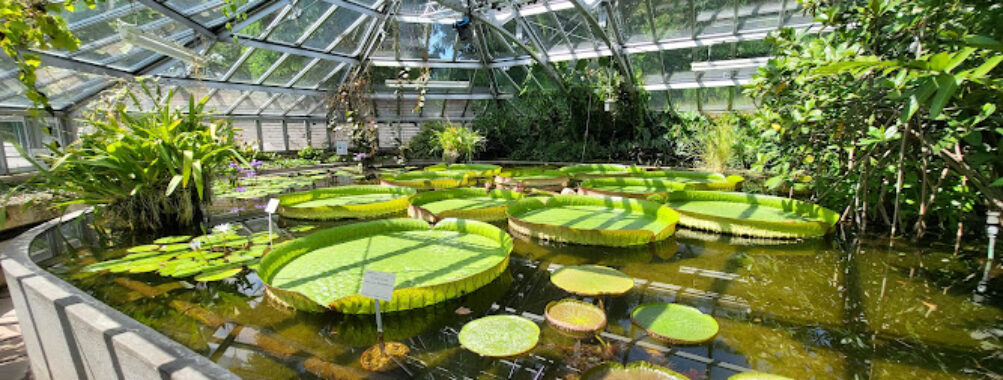
Gruson-Gewächshäuser
“`html
Table of Contents
Description
The Gruson-Gewächshäuser in Magdeburg, Germany is a fascinating attraction that combines the worlds of botanical gardens, aquariums, and cultural history all under one roof. Established in the late 19th century, these greenhouses were originally funded by the wealthy industrialist Hermann Gruson, who had a passion for exotic plants and wanted to create a place where science and beauty could coexist. After significant damage during World War II, the greenhouses were carefully restored, and today they stand as both a living museum and a lush escape for travelers who crave an encounter with nature’s diversity.
Walking inside, you’re instantly greeted with a tropical warmth. It doesn’t matter if it’s the dead of winter outside—the atmosphere transports you straight into a rainforest, desert, or even a peaceful orchid haven. And while some visitors come simply to admire the plants, others enjoy the educational displays and aquariums filled with unusual creatures, which really broaden the experience beyond just “looking at flowers.” It’s that mix that makes it a popular spot for tourists, families, school groups, and even locals who just want a breath of fresh air away from city life.
While the occasional visitor might feel the complex is a little smaller than expected, or wish for more interactive elements, the overall sentiment is overwhelmingly positive. The thoughtful curation of plants, the thriving range of orchids and cacti, the kid-friendly atmosphere, and the gentle sense of discovery make this place easy to recommend for most types of travelers. From my perspective, it’s one of those slightly underrated gems in Magdeburg—you come for the plants but leave with a surprising sense of calm and learning.
Key Features
- Collection of rare cacti, some of them towering like sculptures and others strikingly small and strange.
- Beautiful orchid exhibits that showcase delicate, colorful blooms—you’ll see varieties you probably won’t spot in an average flower shop.
- Aquariums with tropical fish and other aquatic life, which add a lively splash of movement among all the greenery.
- Themed plant houses, including tropical rainforests and dry desert landscapes, all under glass roofs from the 19th century.
- Exotic water plants, including giant Amazonian water lilies that are always a crowd favorite.
- Kid-friendly environment with educational displays suited to school-aged children and curious adults alike.
- Wheelchair-accessible paths, restrooms, and parking, making it a welcoming destination for all visitors.
- On-site amenities such as public restrooms and modern payment options including cards and mobile payment methods.
Best Time to Visit
Honestly, this is one of those rare places that is just good year-round, and for different reasons. In cold months, stepping inside feels like a much-needed escape to somewhere warm and bright, while in summer it blends perfectly with a day of exploring the city. If you’re the type who enjoys smaller crowds, weekdays tend to be calmer, particularly in the mornings. Orchids often bloom magnificently in winter and spring, while the cacti will easily hold their charm all year. If photography is your thing, morning light filtering through the glass domes can be magical. A word of advice though—on hot summer days, the greenhouses can get steamy, so pack light clothes for comfort.
How to Get There
The greenhouses are located not far from Magdeburg’s city center, which makes them pretty easy to reach whether you’re traveling by car, tram, or even on foot if you’re already wandering around downtown. Public transportation is straightforward and affordable in this city, and signage is usually clear enough that even if you don’t speak German, you’ll likely manage with little trouble. Taxis and ride-share services are available, too, but the convenience of the tram stops nearby makes public transit the best bet in my opinion. Parking facilities are available if you’re driving, and the accessibility-friendly design makes arrival stress-free for all guests.
Tips for Visiting
First off, set aside at least an hour or two to visit properly—though plant lovers could linger far longer if they wanted to. If you’re coming with kids, encourage them to look closely at the tiny details. From unusual seed pods to brightly colored fish in the aquariums, there’s a lot for little eyes to notice. And don’t rush—it’s one of those places that rewards slowing down and letting your curiosity lead you.
Photography is generally welcomed (without flash), so bring your camera or phone fully charged—those giant water lilies and odd cactus shapes make for fun photos. If you don’t like battling crowds, avoid peak weekend afternoons. Bring a bottle of water in summer because the humidity can genuinely wear you out. When it comes to accessibility, you’ll find modern standards met: wide pathways, ramps, and helpful restroom facilities are in place.
And here’s something I found personally helpful—take a notebook or use your phone notes if you’re into gardening. Many of the labeled plants here can inspire ideas for your own backyard or even just for picking up a new houseplant on your return home. Lastly, don’t expect an enormous “big city attraction” vibe. This isn’t a noisy theme park or a vast international garden; it’s more of a cozy yet diverse retreat. That authenticity, however, is really what makes the Gruson-Gewächshäuser in Magdeburg, Germany linger in memory long after the visit.
“`
Location
Places to Stay Near Gruson-Gewächshäuser
Find and Book a Tour
Explore More Travel Guides
No reviews found! Be the first to review!